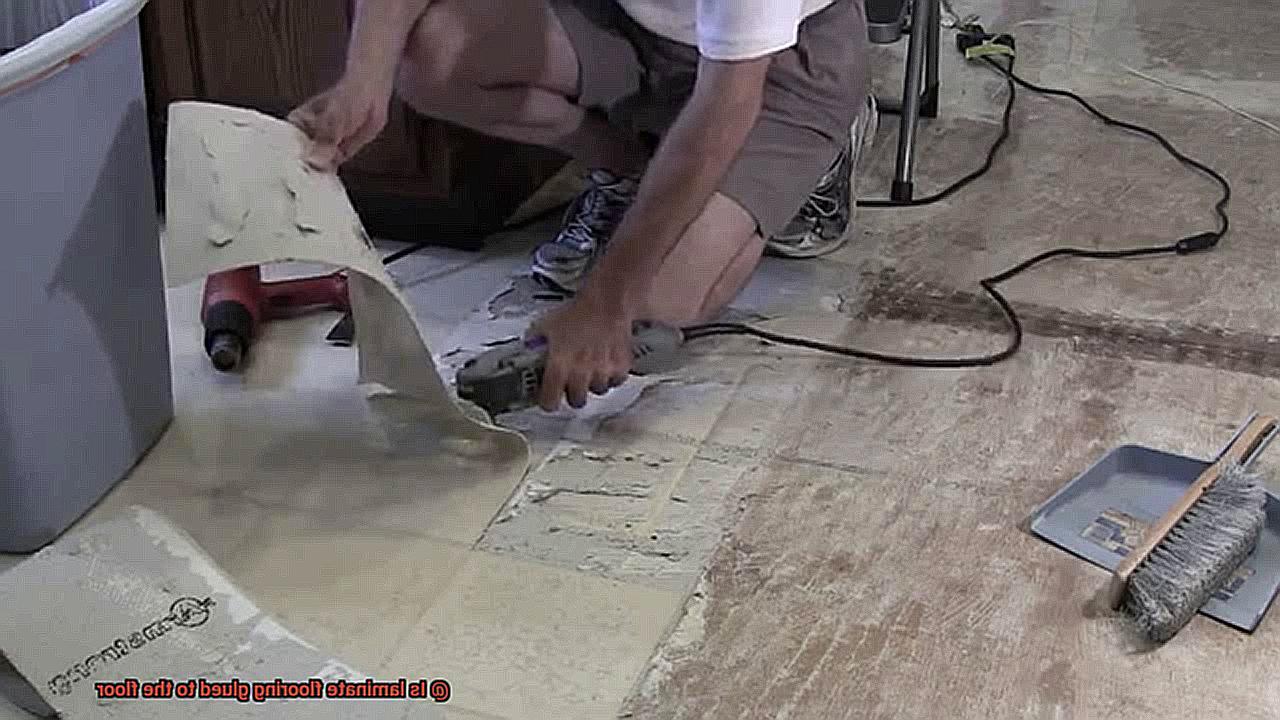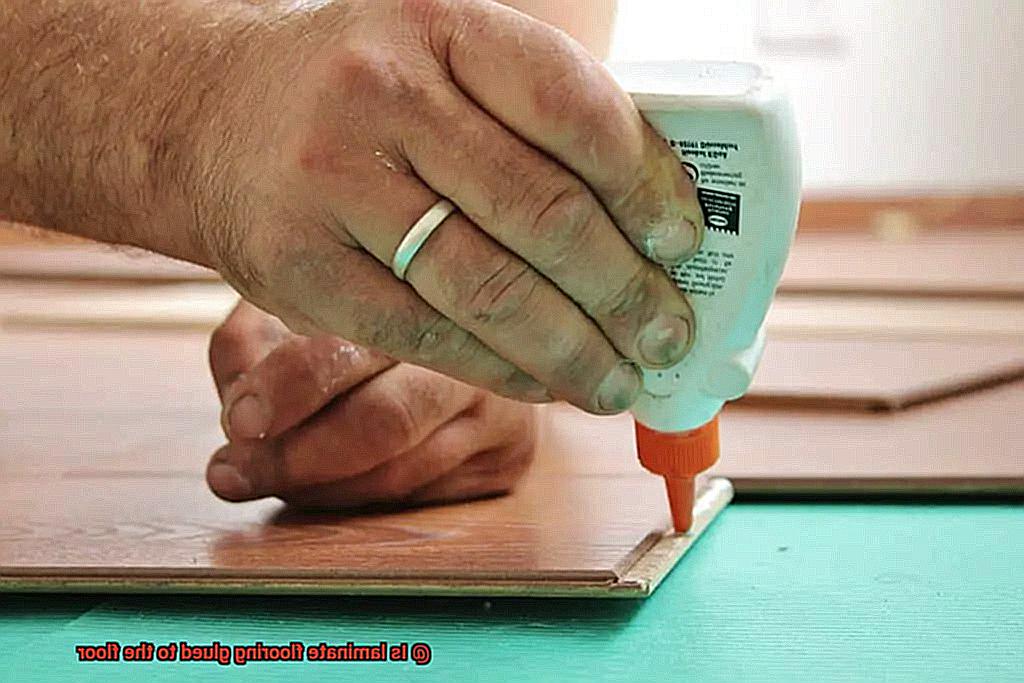Are you considering a flooring upgrade for your home, but not sure if laminate is the way to go? One of the most common questions that come up when it comes to laminate flooring is whether or not it’s glued to the floor. Laminate flooring has gained popularity among homeowners as an affordable alternative to hardwood floors. But, before making your decision, it’s crucial to understand how it’s installed.
We all want our floors to be durable, low maintenance, and long-lasting. Luckily, laminate flooring checks all those boxes and can be easily installed without breaking the bank. Traditionally, adhesive glue was used during installation; however, modern technology has made it possible to install laminate floors without any glue.
In this blog post, we’ll delve into the question “Is Laminate Flooring Glued to the Floor?” We’ll explore what materials make up laminate flooring, the benefits and drawbacks of glue-down installation versus alternative methods without glue. Plus, we’ll guide you on how to choose the best installation method based on your specific needs.

Whether you’re a first-time homeowner or a DIY enthusiast looking for a home renovation project, we’ve got you covered. Keep reading to learn everything you need to know about installing laminate floors in your home.
What is Laminate Flooring?
Contents
- 1 What is Laminate Flooring?
- 2 Benefits of Laminate Flooring
- 3 Types of Installation Methods for Laminate Flooring
- 4 Floating Installation Method
- 5 Glue-Down Installation Method
- 6 Advantages and Disadvantages of Each Installation Method
- 7 Manufacturer Guidelines for Installing Laminate Flooring
- 8 Conclusion

It’s a versatile and practical option that is composed of multiple layers, each with its own unique purpose. The top layer is a clear protective layer that provides durability and resistance to scratches, stains, and fading.
Meanwhile, the design layer gives the flooring its appearance and can mimic natural materials like wood or stone. The core layer provides stability and strength to the flooring, while the backing layer prevents moisture from seeping into the material.
One of the significant advantages of laminate flooring is its ease of installation. Unlike solid hardwood flooring, it doesn’t need to be nailed or glued down to the subfloor. Instead, it uses a floating installation method where individual planks are interlocked together using a click-and-lock system. This feature makes it easy to install and remove, which makes it an excellent choice for homeowners looking to update their floors.
However, there are situations where glue may be used during installation. For example, if the subfloor is uneven or has imperfections, a layer of glue may be applied to create a smoother surface. Also, in high-traffic areas or rooms with moisture issues, glue may be used to provide extra stability and prevent shifting or movement of the planks.
It’s essential to note that not all laminate flooring products are designed for glue-down installations. Manufacturers usually provide instructions on the recommended installation method for their products, so it’s crucial to follow these guidelines to ensure proper installation and performance of the flooring.
Benefits of Laminate Flooring
As an expert on the benefits of this popular choice, I can confidently say that laminate flooring ticks all the boxes.
Let’s start with durability. Laminate flooring is incredibly tough and can withstand heavy foot traffic without showing any signs of wear and tear. This makes it an ideal choice for high-traffic areas like hallways and living rooms. Plus, it’s resistant to scratches, dents, and stains, so even if you have kids or pets, your floors will still look great.
But durability isn’t the only benefit of laminate flooring. It’s also incredibly affordable compared to other flooring options like hardwood or tile. And because it’s easy to install, you won’t have to spend a fortune on installation costs either.
Affordability doesn’t mean sacrificing style with laminate flooring. With a wide variety of styles and designs available, you can achieve the look you want without breaking the bank. Whether you’re going for a rustic farmhouse feel or a sleek modern vibe, there’s a laminate flooring option for you.
Maintenance is also a breeze with laminate flooring. Unlike other types of flooring that require waxing or polishing, all you need to do is clean it with a damp mop or vacuum it regularly to keep it looking new.
And if you’re eco-conscious, laminate flooring is an excellent choice. It’s made from recycled materials and doesn’t contain harmful chemicals like formaldehyde. So not only will you be making a sustainable choice for the environment, but you’ll also be saving money and adding style to your home.
Types of Installation Methods for Laminate Flooring
Not many people know that there are different types of installation methods available for laminate flooring. Let’s explore the five different types of installation methods for laminate flooring.
Floating Installation:
Floating installation is the most common type of installation for laminate flooring. This method involves laying the planks on top of an underlayment without any adhesive. The planks are then locked together using a click-and-lock system. One of the benefits of this method is that it’s easy and quick to install, making it an ideal option for DIYers. Additionally, because there’s no adhesive used, the planks can be easily replaced in case of damage.
Glue-Down Installation:
Glue-down installation involves applying adhesive to the subfloor before laying the laminate planks down. This creates a permanent bond between the floor and subfloor, making it ideal for high-traffic areas or rooms with moisture issues. However, this method can be challenging, time-consuming, and messy, so it’s recommended to hire a professional if you opt for this installation method.
Click-and-Lock Installation:
Click-and-lock installation is a newer method that allows planks to snap together without the use of adhesive or nails. This method is particularly popular among DIY enthusiasts as it’s easy to install and doesn’t require any special tools or skills. Another benefit of this method is that the planks can be easily replaced in case of damage.
Glueless Click-Lock Installation:
The glueless click-lock installation is the most popular and easiest to install. It involves interlocking the planks together without any need for adhesive. This method is ideal for DIYers who want a quick and easy installation process without any mess or fuss. Additionally, because there’s no adhesive used, there’s no need to wait for it to dry and cure, allowing you to use your floors right away.
Pre-Glued Laminate Flooring:
Pre-glued laminate flooring is a variation of the glued laminate flooring method. The planks come with adhesive already applied to the underside, making installation faster and easier. However, this type of installation may not be as secure as other methods. Additionally, because the adhesive is pre-applied, it may not be strong enough to hold the planks together in high-traffic areas.
Floating Installation Method
Look no further than the floating installation method for laminate flooring.
As an expert in this field, I can confidently say that the floating installation method is a popular choice among homeowners and professionals alike. This innovative method does not require glue or adhesive to attach the planks to the subfloor. Instead, the planks are interlocked and laid directly onto an underlayment, which can be made of foam or cork.
One of the main benefits of this method is its ease and speed of installation. It can be done quickly and efficiently, without the mess and hassle of glue. This means less downtime for your space, allowing you to enjoy your new flooring sooner rather than later.
In addition to being easy to install, the floating installation method also allows for easy removal and replacement of damaged planks. Unlike traditional methods that require glue or adhesive, you can simply remove the damaged plank without disturbing the rest of your flooring. This makes repairs easier and more cost-effective in the long run.
To ensure a successful floating installation, it’s important to have a level and clean subfloor. Any bumps or debris can cause the planks to shift or create gaps. Choosing the right underlayment is also crucial for providing cushioning and sound insulation. A quality underlayment will not only enhance the comfort of your flooring but also reduce noise levels in your space.
While some manufacturers may recommend using adhesive on the edges of the planks for added stability, this is not necessary in most cases. With proper installation techniques and a quality underlayment, you can achieve a stable and secure flooring surface without any extra steps.
Glue-Down Installation Method
The glue-down installation method may be just what you need. As an expert in flooring, I’m here to give you a comprehensive breakdown of this installation method.
The glue-down method involves using adhesive to attach each laminate plank directly to the subfloor. This creates a more permanent installation than other methods like floating or click-lock. Plus, it helps to reduce noise levels by eliminating any hollow sounds that may occur with floating installations.
But before you commit to this installation method, there are some factors to consider. Firstly, installing laminate flooring using glue can be more time-consuming and difficult than other methods.
Each plank must be individually glued down, which can take longer and require more labor. Secondly, if any planks need to be replaced or repaired in the future, it can be challenging to do so without damaging surrounding planks.
Another important consideration is the condition of your subfloor. It must be clean, dry, and level to ensure that the planks adhere properly and don’t shift or buckle over time. If your subfloor has any bumps or imperfections, it may need to be leveled before installation.
Despite these potential drawbacks, the glue-down installation method can provide a more secure feel underfoot, especially in high-traffic areas. It’s often used in commercial settings for this reason. Plus, using adhesive can help to reduce noise levels and create a more stable feel.
Advantages and Disadvantages of Each Installation Method
There are two common methods: gluing the laminate flooring directly to the subfloor and using a floating floor system. Each has its own set of advantages and disadvantages.
Gluing laminate flooring directly to the subfloor is a popular method because it creates a stable and durable floor. The glue helps hold the planks in place, preventing movement or shifting over time. Additionally, it can be more affordable as it does not require additional materials like underlayment. However, this method can be more difficult and time-consuming as careful preparation of the subfloor is necessary. Any bumps or imperfections can affect the final result, and mistakes during installation can be challenging to fix.
Alternatively, using a floating floor system involves laying an underlayment layer on top of the subfloor and clicking the laminate planks together on top of it. The advantage of this method is that it is relatively easy and quick to install. It can also be a good option for DIY enthusiasts who want to save on installation costs. However, floating floors may be less stable than glued-down floors and can make more noise when walked on due to more space between the planks and the subfloor.
When choosing an installation method, there are several factors to consider. Budget, skill level, and personal preference all play a role in determining which method is best for your specific situation. Both gluing and floating methods have their advantages and disadvantages, so it ultimately comes down to what works best for you.
Manufacturer Guidelines for Installing Laminate Flooring
These instructions are critical to ensuring a successful and long-lasting installation that will keep your floors looking great for years.
First and foremost, the manufacturer’s guidelines will specify whether or not adhesive is needed for your specific laminate flooring product. Some products can be installed without glue, while others require adhesive on both the subfloor and the back of each plank. Be sure to read these instructions carefully and use the recommended type and amount of adhesive specified by the manufacturer.
In addition, following the manufacturer’s guidelines can help you avoid any potential warranty issues. If you install your laminate flooring incorrectly, it could void the product warranty, costing you time and money in the long run.
But that’s not all – the guidelines may also include important information about subfloor preparation. It’s crucial to properly prepare the subfloor for a level surface that won’t cause issues with your laminate flooring later on. The guidelines may also provide specific instructions for acclimating the flooring to your home’s environment before installation, which is an important step in preventing damage or warping.
l7p2ubU269s” >
Conclusion
To wrap up, laminate flooring is an excellent choice for those who want to enhance their floors without breaking the bank. One of the most frequently asked questions about laminate flooring is whether it’s glued to the floor or not. The answer depends on the type of product and installation method you choose.
Laminate flooring comprises several layers, each with a specific purpose. The top layer offers durability and protection against scratches, stains, and fading, while the design layer gives it its unique appearance. The core layer provides stability and strength to the flooring, while the backing layer prevents moisture from seeping in.
There are various installation methods available for laminate flooring, including floating installation, glue-down installation, click-and-lock installation, glueless click-lock installation, and pre-glued laminate flooring. Each method has its own pros and cons depending on your specific requirements.
It’s critical to adhere to the manufacturer’s instructions when installing laminate flooring to ensure proper installation and performance of your new floors. These guidelines will specify whether adhesive is required for your particular product and provide essential information about subfloor preparation.
Regardless of which installation method you select, laminate flooring boasts numerous advantages such as durability, affordability, ease of maintenance, eco-friendliness, and a vast array of styles and designs.






